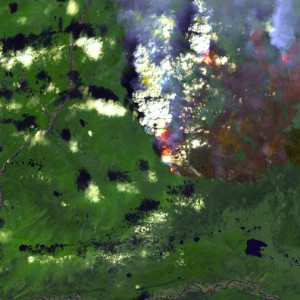Burned Alaska may cause more burned Alaska
July 7, 2010
907-474-7468
7/7/10
The blackened scars that Alaska fires leave on the landscape may result in more lightning, more rain in some areas just downwind of the scars, and less rain farther away, according to two scientists. Nicole Mölders and Gerhard Kramm, both of the Geophysical Institute at the University of Alaska Fairbanks, study how changes in landscapes affect the weather.

After Alaska's fire season in 2004, when smoke befouled much of the air Alaskans breathed and a collective area the size of Vermont burned, the scientists wondered how all that charred country would affect local weather patterns.
The researchers used MM5, a computer model based at Penn State University and the National Center for Atmospheric Research, to simulate conditions on the ground and in the air above it. They compared the surface of Alaska before and after Alaska's record fire season, in which 6.72 million acres burned. The model told them that fire scars larger than 250,000 acres (about the space taken up by the five boroughs of New York City) have an impact on weather close to the fire scar. "There's more rain locally, in the lee side of the scar and then less precipitation farther out," Mölders said. "It's a far-reaching impact." She and Kramm also said fire scars might be responsible for flash floods in areas close to them, and fire scars might also help generate lighting strikes.
"Formation of thunderstorms is more likely (around large fire scars) than in the unburned forest," Kramm said. Burned areas may be weather-makers because hot fires destroy trees, shrubs, moss, and other plants that cool the soil and the surrounding air. Satellite sensors have shown higher summer temperatures in a fire scar in Canada up to 15 years after the burn, Mölders said.
Mölders said fire scars might create the following weather-altering scenario: The warm soil in a burned area heats up the air above it, and that hot, dry air rises. Moist air from unburned areas rushes in to fill the void, and that moist air also rises. That air cools as it rises, reaches a saturation point and condenses into a cloud that lifts higher than surrounding clouds.
That cloud, now loaded with moisture, reaches a level where graupel, ice pellets that resemble tiny hailstones, forms. As graupel particles rise, electrical charges occur within the cloud and increase the possibility of lightning strikes.
The cloud moves downwind and releases its moisture as rain adjacent to the fire scar. After the cloud dumps its load, areas farther away don't receive any rain where they possibly would have if a fire scar were not located upwind.
Though the model tells the researchers that large fire scars affect summer weather, fire scars seem to cool the landscape after the snow falls. A group of scientists, including UAF's Terry Chapin, studied areas around Delta Junction that burned three, 15, and about 80 years ago. Looking at the sun's radiation absorbed all year, rather than just summer, they found that the burn-scar sites absorbed less heat year-round, mostly because snow covered more of the ground surface of recently burned sites during winter.
Mölders and Kramm want to use a new weather research and forecasting computer model to combine the effects of burn scars in summer with local weather. They hope to develop forecasts that might help firefighters and pilots of small aircraft that operate around fire scars.
This column is provided as a public service by the Geophysical Institute,
University of Alaska Fairbanks, in cooperation with the UAF research
community. Ned Rozell is a science writer at the institute. This column
first appeared in 2006.


